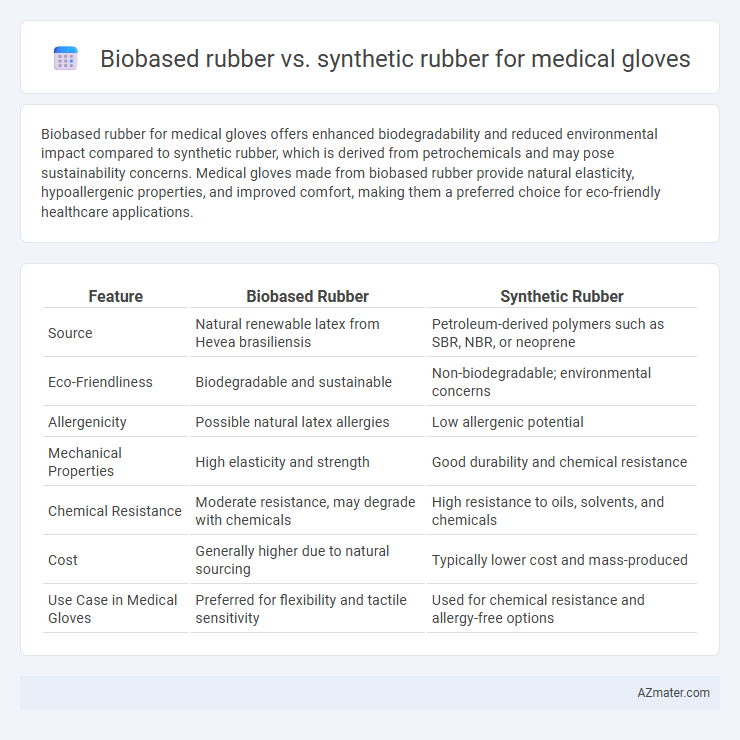Biobased rubber for medical gloves offers enhanced biodegradability and reduced environmental impact compared to synthetic rubber, which is derived from petrochemicals and may pose sustainability concerns. Medical gloves made from biobased rubber provide natural elasticity, hypoallergenic properties, and improved comfort, making them a preferred choice for eco-friendly healthcare applications.
Table of Comparison
| Feature | Biobased Rubber | Synthetic Rubber |
|---|---|---|
| Source | Natural renewable latex from Hevea brasiliensis | Petroleum-derived polymers such as SBR, NBR, or neoprene |
| Eco-Friendliness | Biodegradable and sustainable | Non-biodegradable; environmental concerns |
| Allergenicity | Possible natural latex allergies | Low allergenic potential |
| Mechanical Properties | High elasticity and strength | Good durability and chemical resistance |
| Chemical Resistance | Moderate resistance, may degrade with chemicals | High resistance to oils, solvents, and chemicals |
| Cost | Generally higher due to natural sourcing | Typically lower cost and mass-produced |
| Use Case in Medical Gloves | Preferred for flexibility and tactile sensitivity | Used for chemical resistance and allergy-free options |
Introduction to Biobased and Synthetic Rubber
Biobased rubber, derived from natural sources such as Hevea brasiliensis latex, offers biodegradability and renewable resource benefits for medical gloves, reducing environmental impact compared to synthetic rubber which is petroleum-based and synthesized through polymerization processes like emulsion or solution polymerization. Synthetic rubbers such as nitrile and neoprene provide consistent quality, chemical resistance, and allergen-free alternatives, making them suitable for medical applications requiring high durability and protection. The choice between biobased and synthetic rubber depends on factors including performance criteria, sustainability goals, and manufacturing scalability in medical glove production.
Key Differences Between Biobased and Synthetic Rubber
Biobased rubber, derived from natural sources like Hevea brasiliensis latex, offers superior biodegradability and reduced environmental impact compared to synthetic rubber, which is petroleum-based and often contains chemical additives. Synthetic rubber, such as nitrile or neoprene, provides enhanced chemical resistance, durability, and hypoallergenic properties essential for medical glove applications. Key differences pivot on source origin, environmental footprint, allergenic potential, and performance characteristics critical for healthcare safety standards.
Raw Materials Used in Medical Glove Production
Biobased rubber for medical gloves primarily derives from natural latex extracted from Hevea brasiliensis trees, offering renewable and biodegradable raw materials. Synthetic rubber used in glove production includes materials like nitrile butadiene rubber (NBR) and styrene-butadiene rubber (SBR), synthesized from petrochemical derivatives such as butadiene and styrene. The choice between biobased and synthetic rubbers affects not only glove performance and allergy potential but also environmental sustainability due to differences in raw material sourcing.
Environmental Impact of Biobased vs Synthetic Rubber
Biobased rubber for medical gloves significantly reduces carbon footprint by utilizing renewable natural resources, unlike synthetic rubber derived from petroleum-based products that contribute to greenhouse gas emissions. The biodegradability of biobased rubber decreases medical waste accumulation, promoting eco-friendly disposal compared to persistent synthetic variants. Life cycle assessments reveal that biobased rubber manufacturing consumes less energy and generates fewer toxic byproducts, underscoring its environmental advantages in the healthcare industry.
Biocompatibility and Allergic Reactions
Biobased rubber used in medical gloves demonstrates superior biocompatibility due to its natural origin, reducing the risk of cytotoxicity and inflammatory responses compared to synthetic rubber. Studies reveal that biobased rubber minimizes allergic reactions, particularly latex allergies, which are prevalent with conventional synthetic rubber gloves containing accelerators and chemical additives. The enhanced biocompatibility and hypoallergenic properties make biobased rubber an optimal choice for sensitive healthcare environments requiring safe and durable glove materials.
Durability and Strength of Medical Gloves
Biobased rubber exhibits enhanced elasticity and puncture resistance, contributing to superior durability in medical gloves compared to some synthetic counterparts. Synthetic rubber, such as nitrile, offers high tensile strength and excellent resistance to chemicals, making gloves more resilient under harsh conditions. The combination of biobased natural rubber's flexibility and synthetic rubber's robustness often leads to medical gloves with optimized strength and prolonged shelf life.
Cost Analysis: Biobased vs Synthetic Options
Biobased rubber for medical gloves generally incurs higher production costs due to raw material cultivation and limited supply chains compared to synthetic rubber, which benefits from well-established petrochemical manufacturing processes. Synthetic rubber offers cost advantages through economies of scale and consistent quality control in mass production, reducing overall expenses for large-scale glove manufacturing. However, increasing demand for sustainable materials and advancements in biobased rubber technology may gradually narrow the cost gap between these two options.
Regulatory Standards and Certifications
Biobased rubber for medical gloves must comply with stringent regulatory standards such as FDA 21 CFR Part 177 and ISO 10993 for biocompatibility, ensuring safety and hypoallergenic properties. Synthetic rubber gloves, often made from nitrile or neoprene, also adhere to these standards but may offer enhanced resistance to chemicals and punctures, meeting ASTM D6319 and EN 455 certifications. Both materials require ISO 13485 certification to guarantee quality management systems specific to medical devices, highlighting their compliance with global health authorities.
Current Market Trends in Medical Glove Materials
The medical glove market is increasingly shifting towards biobased rubber due to rising demand for sustainable and eco-friendly materials, as it offers comparable barrier protection and elasticity to synthetic rubber. Current trends highlight a surge in biobased nitrile and natural rubber blends, driven by regulatory pressure and consumer preference for biodegradability and lower carbon footprints. Synthetic rubber remains dominant for its consistent quality and resistance to chemicals, but biobased alternatives are rapidly gaining traction in medical applications due to improved material science innovations.
Future Prospects for Biobased Rubber in Healthcare
Biobased rubber presents sustainable and hypoallergenic advantages over synthetic rubber for medical gloves, with increasing demand driven by environmental regulations and patient safety concerns. Advances in biotechnology are enhancing the quality and elasticity of biobased rubber, making it a competitive alternative for medical applications. The healthcare industry anticipates wider adoption of biobased rubber gloves due to their reduced carbon footprint and potential for biodegradability, aligning with global sustainability goals.

Infographic: Biobased rubber vs Synthetic rubber for Medical glove
 azmater.com
azmater.com